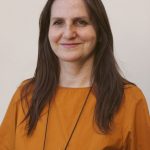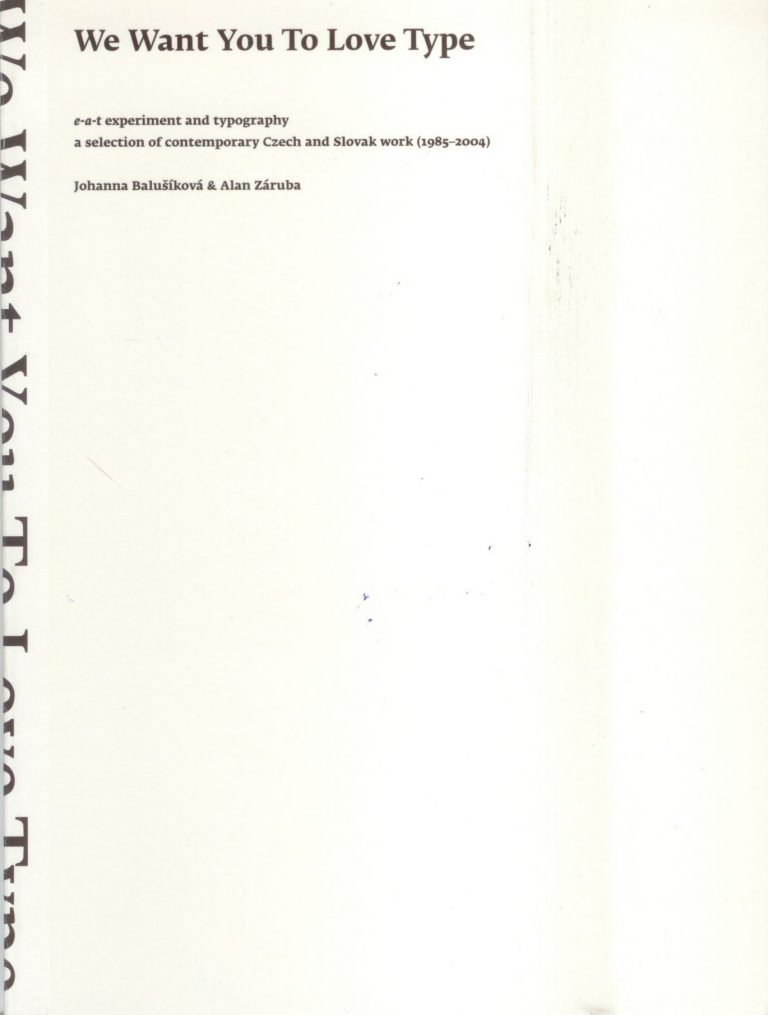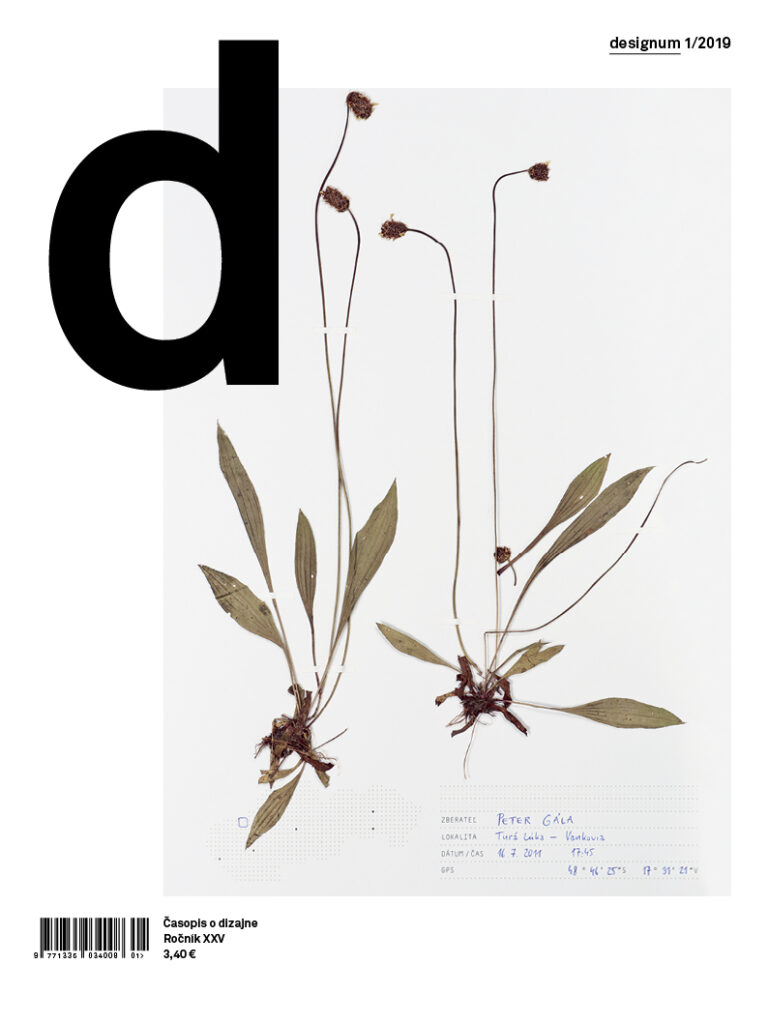Velvet Generation: Johanna Biľak Balušíková
Slovenskú verziu rozhovoru nájdete nižšie.
The interview was created on the occasion of the Velvet Generation exhibition taking place at The Embassy of the Slovak Republic in London as a part of the celebrations of the 30th anniversary of November ’89.
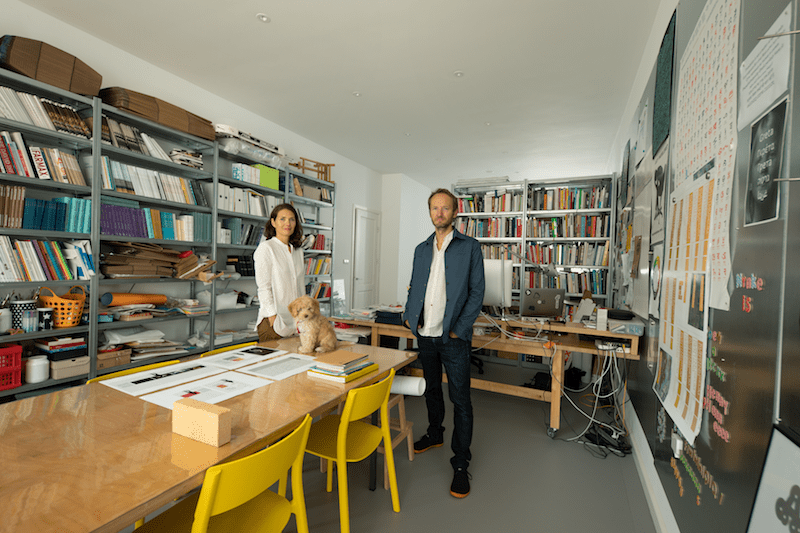
Portrait of Johanna and Peter Biľak in the Typotheque Studio in The Hague, The Netherlands (© Šymon Kliman)
How old were you in the time of the Revolution, and what were you doing? What events and feelings came with the change?
I was 15 years old and studied in the second year of a grammar school in Považská Bystrica. The Revolution changes there differed from those in Bratislava. Slow, less unrestrained. As if people didn’t believe what was going on. Simply life went on and at the same pace up to a point when the situation was no longer tenable. That’s why I didn’t experience the Revolution so radically. However, gradually, the topics in the textbooks we used in the grammar school changed; new writers are added in literature — those who had been dissidents or banned. I was happy that they finally lacked the politicised undertone. We suddenly had less Russian, and English was added, which I had always wanted to learn. Lecturers from abroad arrived. When I was seventeen, my parents took me to Paris. We went around all the museums: Musée d’Orsay, Centre Pompidou — it was a great cultural shock for me. I think the West also welcomed us. When people saw our buses, they waved to us; and it wasn’t a cold welcome. Even the French were glad that the wall had fallen and everyone was curious about what was happening here. I remember I was crying behind a window with emotion.
Did you go to study to AFAD after grammar school?
Yes, my great luck was that they accepted me to AFAD right from grammar school. I ended up in graphic design, I originally went to graphics. As a part of the post-Revolutionary mood, I was attending Palo Choma’s classes at the folk art school in Žilina during studying in grammar school. Choma’s studio was my world, and I knew that I somehow belong to that world. At home, we did free works, and then we spread them out on the ground and talked about them. He commented on them, and we could all say something about them. Overall, Žilina influenced me at the time; in Považská Gallery, they organised a good exhibition which emanated freedom.
What did you pursue at AFAD?
It was rather about politics there, content, these were the first steps. Everything was just being set up. After all, the well-known statement by Ľubo Longauer was that he isn’t teaching because he has to try to get toilet paper. It was really financially demanding, new departments were emerging. The Promotional Poster changed to Graphic Design, and later to Visual Communication. It was a rather turbulent period of setting up the system in which the first computers appeared.
But projects started to arrive at school. For example, in France, they announced a competition for a logo of the festival of Slovak culture — Présences Slovaques. And all of a sudden, all class was working on the logo. I won the competition, and the reward was that I could spend a month in Paris in Cité internationale des Arts. I was staying in the center of Paris, they paid my travel costs; I got a scholarship and free access to all the museums in the city of Paris. It was incredibly positive.
What did you pursue during your studies? Did you focus on something?
We started making the first fonts because we missed them in making graphic design. But at school, there were no lessons on type design; and later at the school in Saint-Étienne, there was no specialist on type or a typographer. Everyone was looking for information from various sources. We had much freedom, but nobody told me that this „A“ is wrong, or the „B“ should have bellies unbalanced. Yet in Saint-Étienne, I understood that type is essential for visual identity-making. There, during my postgraduate studies, I was making a visual identity for a design biennial which was a large scale project for one agency. First, I designed the layout of the Azimuts magazine and then also the first identity of Biennale Design de Saint-Étienne, where I was confronted with the challenges of typography and layout. I wanted to try designing my own font under the guidance of professionals. So I went to study in Paris to pursue type design at ANRT (Atelier National de Recherche Typographique).
There was still a euphoria in Slovakia of the nineties, but you went to the West, and you were confronted with something else…
In France, there was a strong communist movement, for example, there was Grapus, Gérard Paris-Clavel — leftists. They invited me to join them in protesting in the streets in a „communist demonstration“. But I had a terrible problem with that. Their views of communism were idealised. The French, as students, were making trips to Poland; and for example, Alain Le Quernec told me about how the Poles were doing fine, how they envied them. Later I realised that communism in Czechoslovakia was a bit different from the one in Poland. Poles had much greater freedom of creation, and we were a lot more censored, and it was harder to get here across the borders. In Paris, it was quite striking that their poster design and one wing of designers was greatly influenced by the Polish poster — by what they saw as „freedom“.
How did the stays work? Did it start right after the Revolution, and did the school already have some connections with abroad?
Yes, it was running very well, it came suddenly. I went abroad to learn something. Saint-Étienne was exciting for me because I could work on big projects there. Students don’t usually have the opportunity, I could visit exhibitions, for example — The International Biennale of Graphic Design in Chaumont, and take part conferences. They told me to come, and make a magazine. It scared me because nobody had taught me how to do book typography, how to select fonts, how the layout works. I knew how to work with a computer, I was skilled in working with design applications. In Saint-Étienne, I could go to a library and order the literature I needed. There I discovered Josef Müller-Brockmann‘ s theory of the grid system (publication Grid Systems in Graphic Design). The Swiss were the first to logically describe the information display system since they had to deal with the hierarchy of text in three languages. So completely paradoxically, I was inspired by the Swiss typography school in France.
After staying in Saint-Étienne, did you remain abroad?
Then the Biennial in Saint-Étienne ended, I wanted to move on. Peter inspired me, he graduated from ANRT (Atelier National de Recherche Typographique) in Paris at type design. It was the field that I still wanted to understand better. The Swiss taught there, too; and I think what worked as well was that I was already interested in the Swiss school in Saint-Étienne. I also did my theoretical bachelor thesis on Swiss designers living in Paris, where I interviewed Jean Widmer, Rudi Meyer, Hans-Jürg Hunziker, etc. Then, I was really fascinated by how clear their idea was on how to organise information on a page to make it both functional and aesthetic. There I also designed the Jigsaw font inspired by geometric typography. Then it wasn’t too far from Paris to the Netherlands because Swiss typography in Paris and Dutch typography are close to each other. But I’d say that the Dutch have even relaxed it — the exactness. So I went to Maastricht where I spent two years at the Jan van Eyck Academie.
Could you compare your situation after graduation and the situation of your classmates who stayed in Slovakia?
What was happening here, and I wouldn’t like it, was a boom in advertising agencies. Just below Drotárska cesta, where AFAD is located, Mark BBDO was in operation. It was like a „school agency“ where almost everyone took turns. I think that I was a substitute for somebody for a few days, and then I told myself that this is not what I want to do. They told me that I was doing „too artistic things“. I just didn’t fit in there.
So were your peers and classmates more into following this direction after graduation?
Even during studies, many people did school and some works, too. They worked in advertising and went to school to mostly consult things. And when they graduated, they either established their agencies or took turns in the few agencies in Bratislava. Although some set up their own studios but to make a living, they had to do commercial things. I think there were two positions: They were either making super cultural things for theatres and the like or had to work in agencies.
Didn’t you work for agencies abroad?
No, they were studios which weren’t making advertising. They were graphic studios; for example, in Paris, I was an intern and later worked at Ruedi Baur — they were making the identity for Centre Pompidou in Paris. Then I worked in the Atalante studio in Paris, their clients were theatres, operas, culture book publishers; it had nothing to do with advertising.
Then when did you decide to go freelance?
When I graduated in Maastricht, I had a dilemma about whether to return to Paris or try working in Dutch studios. At that time, we still had to have a work permit. Finally, they hired me to a graphic design studio in Amsterdam; it wasn’t very famous and made a living by designing annual reports. I had creative freedom there, but when I was making the fourth annual report, I had enough. Then I got a job in a very interesting studio of exhibition architects, Kossman en de Jong, who were just looking for somebody specialising in typography and type. After two years there, I went freelance.
How did you start cooperating with Peter, and what are all the things you do now?
Peter lived in The Hague and established Typotheque when I was still studying in Maastricht. After Maastricht, I also moved to The Hague and started my own business. Later, it was logical to team up with Peter in Typotheque. In cooperation, I organised an exhibition series together with Alan Záruba called e-a-t (experiment and typography). In 2005 I officially became a partner in the company. We didn’t wait for clients to contact us, but we designed our own stuff. So we were considering what products the company could make; Peter was mostly designing fonts, I mainly did T-shirts and small identities. I already had research material ready, I wanted to create a children’s font. But then our daughter was born, and I didn’t get to it anymore. My maternal life changed my priorities a little because Peter worked at the company to the full.
What other projects does Typotheque work on?
We cooperate intensively with Nikola Djurek, who works a lot with Peter on projects with fonts. With Andrej Krátky, we organise the Fontstand project and own conference, which is also about software development and online selling of fonts. But I still had the feeling that my place is somewhere working with children as I was spending much time with daughter. Besides, I could see that the generation is entirely different in motor activity than we were. They can’t hold a pencil, and in the Netherlands, many parents are looking for art education for children — clubs. So I founded a small studio for kids — Kids Atelier; it’s my hobby — a matter of the heart.
How long have you been doing this job?
Four years. We’ve got a blog with all works published. There are about 50% of foreigners living in The Hague, so now we have a majority of English-speaking children.
Could you compare in what exactly are the possibilities for professional fulfilment or succeeding in the market different for a designer in Slovakia and the Netherlands?
I sometimes imagine what I would do in Slovakia if I came back. Some product, I would probably produce some product that would be published. Someting that’s missing or would be a help. I would enjoy that there’s much work in Slovakia. I’m the kind of person who helps when something doesn’t work. But I miss that in the Netherlands, everything works too well here, and that’s even boring. You don’t have the feeling you’re important in some change, you must follow aesthetics, but now maybe ecology more. I would enjoy thinking up something that helps the environment.
If the change in regime hadn’t taken place, do you think your life and work would have looked differently?
Maybe I would work in a local printer or in a regional newspaper doing layout (laughter). I wouldn’t go to live abroad. My parents weren’t in the Communist Party, my assessments would be negative, and there’d be a risk that I wouldn’t get to college.
You haven’t lived in the former regime for many years. Anyway, do you have the feeling that this experience influenced you somehow, for example, in your behaviour or professional advancement?
A Dutch woman recently told me that people from our countries are reminiscent of the characters from Kundera’s The Unbearable Lightness of Being. As if we couldn’t relax completely, as if we still had something in us from the past as if we were somehow overlaid … We sure have something ‚engraved‘. Especially our generation. When you look at our parents — there’s still that feeling of fear and some concerns — they’ve lived in that oppression. We’ve only experienced it halfway; I think that when I came to the West, I wasn’t confident. But I had to learn to speak up, voice my opinion, express myself. There’s much more discussion here.
Johanna Biľak Balušíková, graphic designer and type designer, she lives and works with her husband, Peter Biľak, in The Hague, The Netherlands. Together with Peter, she is a partner in the internationally renowned studio and digital type foundry Typotheque. She is an excellent artist/draughts-woman, but on the other hand, also an organiser. She has established and runs her own project in The Hague — a creative workshop Kids Atelier.
Interviewed by: Barbora Komarová, Mária Rišková
Translation: Katarína Kasalová
Rozhovor bol vytvorený pri príležitosti výstavy Velvet Generation konanej na Slovenskom veľvyslanectve v Londýne ako súčasť osláv 30. výročia Novembra ’89.
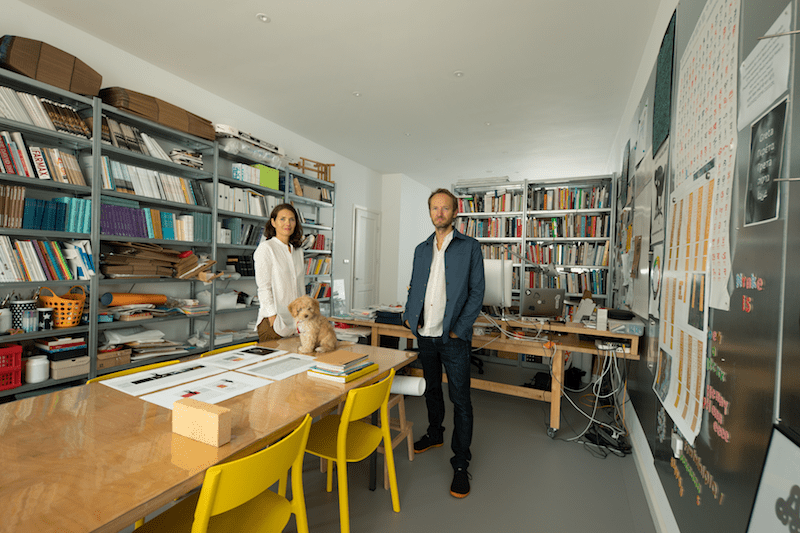
Portrét Johanny a Petra Biľakovcov v ateliéri Typotheque v Haagu, Holandsko (© Šymon Kliman)
Koľko rokov si mala v čase prevratu a čo si robila? Aké udalosti a pocity zmenu sprevádzali?
Mala som 15 rokov a študovala som v druhom ročníku na gymnáziu v Považskej Bystrici. Tam boli revolučné zmeny iné ako v Bratislave. Spomalené, menej živelné. Akoby ľudia neverili, čo sa deje. Jednoducho život išiel stále rovnakým tempom až do bodu, v ktorom už situácia nebola udržateľná. Preto som revolúciu neprežívala až tak radikálne. Postupne sa však menili témy v učebniciach, ktoré sme používali na gymnáziu, v literatúre pribudli noví spisovatelia, ktorí boli disidenti alebo zakázaní. Tešila som sa, že konečne v nich nebolo cítiť spolitizovaný podtón. Zrazu sme mali menej ruštiny a pribudla angličtina, ktorú som sa vždy chcela učiť. Prišli lektori zo zahraničia. Keď som mala sedemnásť, rodičia ma zobrali do Paríža. Obehli sme všetky múzeá, Musée d’Orsay, Centre Pompidou, bol to pre mňa veľký kultúrny šok. Myslím si, že aj Západ nás vítal. Keď ľudia videli naše autobusy, tak nám mávali, a nebolo to chladné privítanie, aj Francúzi boli radi, že múr padol a všetci boli zvedaví, čo sa u nás deje. Pamätám si, že som za oknom plakala od dojatia.
Po gymnáziu si išla študovať na VŠVU?
Áno, mojím veľkým šťastím bolo, že ma zobrali z gymnázia na VŠVU hneď na prvýkrát. Skončila som na grafickom dizajne, pôvodne som išla na grafiku. Ako súčasť porevolučnej nálady som chodila ešte počas gymnázia k Palovi Chomovi do ľudovej školy umenia v Žiline. Chomov ateliér bol môj svet, vedela som, že do toho sveta nejakým spôsobom patrím. Doma sme robili voľné práce a potom sme ich rozložili po zemi a rozprávali sme sa o nich. On sa k nim vyjadril a všetci sme k tomu mohli niečo povedať. Žilina ma celkovo v tom čase ovplyvnila, v Považskej galérii organizovali dobré výstavy, z ktorých sálala sloboda.
Čomu ste sa venovali na VŠVU?
Tu sa riešila skôr politika, obsah, to boli úplne prvé roky. Všetko sa ešte len nastavovalo. Veď známy výrok Ľuba Longauera bol, že on neučí, lebo musí zháňať toaletný papier. Naozaj to bolo finančne náročné, vznikali nové oddelenia. „Propagačný plagát“ sa zmenil na grafický dizajn a neskôr na vizuálnu komunikáciu. Bolo to dosť búrlivé obdobie nastavovania systému, do ktorého sa objavili prvé počítače.
Ale na školu začali chodiť projekty, napríklad vo Francúzsku vyhlásili súťaž na logo ‘Présences Slovaques’, festival slovenskej kultúry, a zrazu celý ročník robil na logu. Ja som tú súťaž vyhrala a odmenou bolo, že som mohla ísť na mesiac do Paríža do Cité internationale des Arts. Bývala som v centre Paríža, hradili mi cestovné náklady, dostala som štipendium a voľný vstup do všetkých múzeí mesta Paríža. Bolo to bolo neskutočne pozitívne.
Čomu si sa počas štúdia venovala ty? Zamerala si sa na niečo?
Začali sme robiť prvé fonty, lebo pri tvorbe v grafickom dizajne nám chýbali. Ale na škole sa dizajn písma nevyučoval, ani neskôr na škole v Saint-Etienne nebol žiaden odborník na písmo alebo typograf. Každý si hľadal informácie v rôznych zdrojoch. Mali sme veľa slobody, ale nikto mi nepovedal, že toto „Áčko“ je zlé, alebo že „Béčko“ by malo mať brušká nevyvážené. Ešte v Saint-Étienne som pochopila, že písmo je veľmi dôležité pre tvorbu vizuálnej identity. Tam som počas postgraduáleno štúdia robila vizuálnu identitu pre bienále dizajnu, čo bol veľký projekt rozsahom pre jednu agentúru. Najprv som navrhovala layout časopisu Azimuts, a potom aj prvú identitu Biennale Design de Saint-Etienne, kde som bola konfrontovaná s výzvami typografie a layoutu. Chcela som si vyskúšať navrhnúť vlastné písmo pod vedením profesionálov, a tak som išla študovať do Paríža tvorbu písma na ANRT (Atelier National de Recherche Typographique).
Na Slovensku bola v deväťdesiatych rokoch ešte poprevratová eufória, ale ty si vtedy išla na Západ a bola si konfrontovaná s niečím iným…
Vo Francúzsku bolo silné prokomunistické hnutie, boli tam napríklad Grapus, Gérard Paris-Clavel, ľavičiari. Volali ma, aby som s nimi išla protestovať do ulíc na „komunistickú demonštráciu“. Mala som s tým však hrozný problém. Ich názory na komunizmus boli zidealizované. Francúzi si ako študenti robili výlety do Poľska a napríklad Alain Le Quernec mi hovoril, ako sa Poliaci mali dobre, ako im vtedy závideli. Neskôr som prišla na to, že v Československu bol trochu iný komunizmus ako v Poľsku. Poliaci mali oveľa väčšiu slobodu v tvorbe a my sme tu boli oveľa viac cenzúrovaní, aj bolo ťažšie dostať sa sem cez hranice. V Paríži bolo dosť markantné, že aj ich dizajn plagátov a jedno krídlo dizajnérov bolo veľmi ovplyvnené poľským plagátom, tou pre nich „slobodou“.
Ako fungovali pobyty? Hneď po prevrate sa to rozbehlo a škola už mala aj nejaké kontakty so zahraničím?
Áno, to bolo veľmi rozbehnuté, prišlo to zrazu. Išla som do zahraničia s tým, že sa tam chcem niečo naučiť. Saint-Étienne bolo pre mňa zaujímavé v tom, že som tam mohla realizovať veľké projekty, ktoré sa k študentom len tak nedostanú, mohla som vidieť výstavy, napríklad bienále grafického dizajnu v Chaumonte a zúčastniť sa konferencií. Povedali mi tam, príď sem a budeš robiť časopis. Zľakla som sa, pretože ma dovtedy nikto neučil, ako sa robí knižná typografia, ako sa vyberajú fonty, ako funguje layout. Vedela som robiť na počítači, ovládala som dizajnérske aplikácie. V Saint-Étienne som mohla ísť do knižnice a objednať si literatúru, akú som potrebovala. Tu som objavila teóriu Josefa Müller-Brockmanna zameranú na systém mriežky (publikácia Grid Systems in Graphic Design). Švajčiari ako prví logicky popísali systém zobrazenia informácií, keďže museli riešiť hierarchiu textu v troch jazykoch. Takže úplne paradoxne som bola vo Francúzsku inšpirovaná švajčiarskou školou typografie.
Po pobyte v Saint-Étienne si už zostala za hranicami?
Keď skončilo v Saint-Étienne bienále, chcela som sa posunúť ďalej. Peter bol pre mňa inšpirácia, absolvoval ANRT (Atelier National de Recherche Typographique) v Paríži na tvorbu písma, čo bola oblasť, ktorú som chcela ešte hlbšie pochopiť. Tam učili tiež Švajčiari, myslím si, že u nich zabralo aj to, že som sa už zaujímala o švajčiarsku školu uz v Saint-Étienne, napisala som aj teoretickú bakalársku prácu o švajčiarskych dizajnéroch žijúcich v Paríži, kde som robila interview s Jeanom Widmerom, Rudim Meyerom, Hans-Jürgom Hunzikerom, atď. Vtedy som bola naozaj fascinovaná tým, akú jasnú predstavu mali o tom, ako informácie na strane zorganizovať tak, aby boli funkčné aj estetické. Tam som navrhla aj font Jigsaw, ktorý bol inšpirovaný geometrickou typografiou. Potom z Paríža už nebolo ďaleko do Holandska, lebo švajčiarska typografia v Paríži a holandská typografia majú k sebe blízko. Ale povedala by som, že Holanďania to ešte uvoľnili, tú exaktnosť. Takže som išla do Maastrichtu, kde som bola dva roky na Jan van Eyck Academie.
Vedela by si porovnať svoju situáciu po skončení školy a situáciu tvojich spolužiakov, ktorí zostali na Slovensku?
Čo sa dialo tu a čo by ma nebavilo, bol boom reklamných agentúr. Hneď pod Drotárskou cestou, kde je budova VŠVU, fungovalo Mark BBDO, to bola skoro „školská agentúra“, kde sa takmer všetci prestriedali. Myslím si, že som tam raz niekoho zastupovala na pár dní, ale potom som si povedala, že toto nie je to, čo chcem robiť. Povedali mi, že robím „príliš umelecké veci“. Jednoducho som tam nezapadla.
Čiže tvoji rovesníci a spolužiaci mali po škole skôr nábeh ísť týmto smerom?
Už aj počas školy, veľa ľudí robilo školu a nejaké práce naraz. Robili v reklamkách a do školy chodili hlavne konzultovať veci. A keď sme školu skončili, tak buď si otvorili svoje reklamky alebo sa striedali v tých zopár agentúrach v Bratislave. Ale niektorí si založili vlastné štúdio, no aby sa uživili, museli robiť komerčné veci. Myslím si, že boli také dve polohy – buď robili nejaké super kultúrne veci, pre divadlá a podobne alebo museli robiť v reklamkách.
Ty si nerobila pre reklamky v zahraničí?
Nie, to boli štúdiá, ktoré nerobili reklamu. Boli to grafické štúdiá, napríklad v Paríži som stážovala a neskôr pracovala u Ruedi Baur, ktorí robili identitu pre Centre Pompidou v Paríži. Potom som robila v štúdiu Atalante v Paríži, ktorých klienti boli divadlá, opery, kultúrne knižné vydavateľstvá, s reklamou to nemalo nič spoločné.
Kedy si sa potom rozhodla ísť na voľnú nohu?
Keď som skončila v Maastrichte, mala som dilemu, či sa mám vrátiť do Paríža alebo si vyskúšať pracu v holandských štúdiách. Vtedy sme ešte museli mať pracovné povolenie. Nakoniec ma zobrali do grafického štúdia v Amsterdame, ktoré nebolo veľmi známe, živili sa dizajnom výročných správ. Mala som tu kreatívnu voľnosť, ale keď som urobila štvrtú výročnú správu, tak som mala dosť. Potom som dostala miesto vo veľmi zaujímavom štúdiu výstavníckych architektov Kossman en de Jong, ktorí práve hľadali niekoho špecializovaného na typografiu a písmo. Po dvoch rokoch u nich som išla na voľnú nohu.
Ako ste začali spolupracovať s Petrom a čo všetko robíš momentálne?
Peter žil v Haagu a začal s Typotheque ešte, keď som študovala v Maastrichte. Po Maastrichte som sa aj ja presťahovala do Haagu a založila som vlastnú firmu. Neskôr bolo logické spojiť sa s Petrom v Typotheque. V rámci spolupráce som organizovala aj sériu výstav spolu s Alanom Zárubom, ktorá sa volala e-a-t (experiment a typografia). V roku 2005 som sa oficiálne stala vo firme partnerkou. Nečakali sme, pokým nás oslovia klienti, ale navrhovali sme vlastné veci. Takže sme rozmýšľali, aké produkty by firma mohla vytvárať, Peter robil hlavne fonty, ja hlavne tričká a malé identity. Už som mala nachystaný výskumný materiál, chcela som robiť detské písmo. Ale potom sa nám narodila dcéra a ja som sa k tomu už nedostala. Materský život mi trochu pomenil priority, lebo Peter pracoval vo firme naplno.
Aké iné projekty sa robia v Typotheque?
Spolupracujeme intenzívne s Nikolom Djurekom, ktorý veľa robí s Petrom na projektoch s fontami. S Andrejom Krátkym zase organizujeme projekt Fontstand a vlastnú konferenciu, ktorá je tiež o rozvoji softvéru na predaj fontov online. Ale ja som stále cítila, že moje miesto je aj niekde pri práci s deťmi, keďže som trávila s dcérou kopec času a videla som, že tá generácia je úplne iná, ako sme boli my, čo sa týka motoriky. Nevedia držať ceruzku a v Holandsku veľa rodičov hľadá pre deti výtvarné vzdelávanie, krúžky. Tak som založila malý ateliér pre deti – Kids Atelier, je to moje hobby, srdcová záležitosť.
Ako dlho robíš túto prácu?
Štyri roky. Máme k nemu blog, kde sú všetky práce publikované. V Haagu žije okolo 50% cudzincov, takže máme teraz väčšinu detí hovoriacich po anglicky.
Vedela by si porovnať, v čom konkrétne sú možnosti uplatnenia alebo presadenia sa dizajnéra na scéne iné v Holandsku a na Slovensku?
Zvyknem si niekedy predstavovať, čo by som robila na Slovensku, keby som sa vrátila. Nejaký produkt, niečo by som asi vyrábala, čo by sa publikovalo. Niečo, čo chýba alebo by to pomohlo. Bavilo by ma, že na na Slovensku je veľa roboty. Som typ človeka, ktorý pomáha, keď niečo nefunguje. Ale v Holandsku mi to chýba, tam všetko až veľmi dobre funguje, až je to nuda. Nemáš pocit, že si dôležitý pri nejakej zmene, musíš pracovať na estetickej báze, aj keď možno teraz aj viac na ekologickej. Bavilo by ma vymyslieť niečo, čo pomáha životnému prostrediu.
Ak by sa zmena režimu nestala, myslíš, že by sa tvoj život a práca v niečom líšili?
Možno by som pracovala v miestnej tlačiarni alebo v regionálnych novinách by som robila layout (smiech). A nešla by som žiť do zahraničia. Moji rodičia neboli v komunistickej strane, mala som zlé posudky a hrozilo mi, že nepôjdem na vysokú školu.
Neprežila si v bývalom režime veľa rokov, ale máš pocit, že ťa tá skúsenosť nejako ovplyvnila, napríklad v tvojom správaní alebo profesionálnom napredovaní?
Jedna Holanďanka mi prednedávnom povedala, že jej ľudia z našich krajín pripomínajú postavy z Kunderovej Neznesiteľnej ľahkosti bytia. Ako keby sme sa nevedeli úplne uvoľniť, ako keby sme ešte stále v sebe mali niečo z minulosti, akoby sme boli nejakí poznačení. Určite máme niečo ‘zakódované’. Hlavne naša generácia. Keď sa pozrieš na našich rodičov – u nich je ešte cítiť ten strach a isté obavy, oni žili v tej neslobode. My sme v tom žili len tak do polovice – myslím, že keď som prišla na Západ, tak som nemala sebavedomie. Ale musela som sa naučiť ozvať sa, povedať svoj názor a prejaviť sa. Tu sa oveľa viac diskutuje.
Johanna Biľak Balušíková (15-ročná v novembri 1989), grafická dizajnérka a dizajnérka písma, s manželom Petrom Biľakom žijú a pracujú v holandskom Haagu. Spolu s Petrom je partnerkou medzinárodne známeho štúdia a digitálnej písmolejárne Typotheque. Je vynikajúcou výtvarníčkou-kresliarkou, no na druhej strane i praktickou organizátorkou. Vytvorila a vedie v Haagu vlastný projekt tvorivých dielní pre deti Kids Atelier.
Zhovárali sa: Barbora Komarová, Mária Rišková

